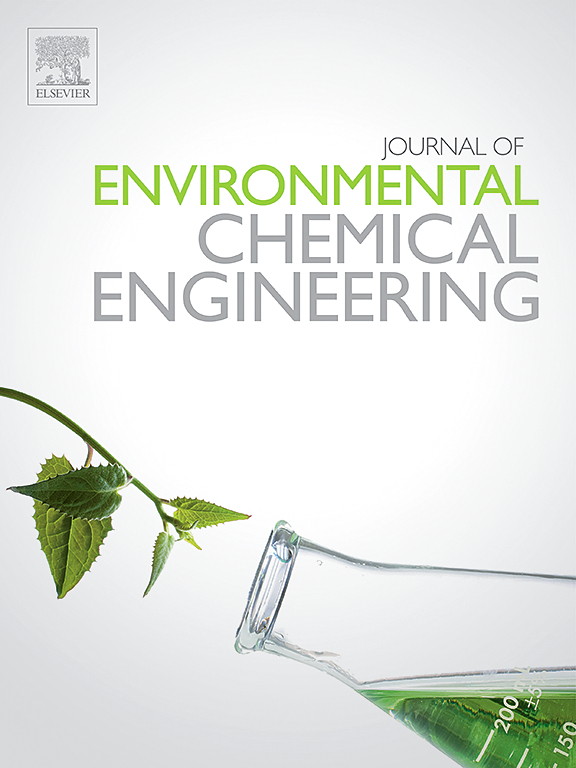Tri-combustion of multi-source solid wastes: Combustion behaviors, ash slagging characteristics, and gaseous pollutants emissions
IF 7.4
2区 工程技术
Q1 ENGINEERING, CHEMICAL
引用次数: 0
Abstract
The huge production of sewage sludge (SS), combustible construction and demolition (C&D) waste, and waste logistics packaging challenges the sustainable development of our cities. Co-combustion is a promising way for multi-source solid waste management due to the efficient volume reduction, waste to energy, and easy operation in existing facilities. Pine sawdust (SD) and polyethylene (PE) were selected as representative components of combustible C&D waste and waste logistics packaging. Their combustion behaviors, ash slagging characteristics, and gaseous pollutants (HCl, NOx, SO₂) emissions were investigated in the tri-combustion process. Results indicate that adding SD and PE reduces burnout temperature (Th) by 188–230 °C and improves both the combustion stability index and comprehensive combustion index (CCI), enhancing SS combustion. The highest CCI value of SS-SD-PE was achieved at 0.5–0.3–0.2. Adding SD and PE elevates the ash fusion temperature, although a significant slagging tendency persists. Higher combustion temperature hinders chlorine fixation. The decrement of NOx emission at high temperature correlates with the catalytic effect of metal oxides like Ca and Fe and the reduction by intermediates such as CO and soot particles. Tri-combustion can promote HCl emission. The lowest HCl emission of 0.274 mg·g−1 is yielded at 0.4–0.3–0.3. The increase in SD and PE blending ratio leads to an increment of N conversion rate from 15.72 % to 24.5 % and from 2.47 % to 27.5 %, respectively. The increment of SD blending ratio promotes SO2 emission, while PE can suppress it. These findings provide a better understanding of the interactions during the combustion of multi-source solid waste.
多源固体废弃物三燃烧:燃烧行为、灰结渣特性及气态污染物排放
污水污泥(SS)、可燃建筑和拆除垃圾(C&;D)和垃圾物流包装的大量产生对我们城市的可持续发展提出了挑战。在现有设施中,混合燃烧具有体积减小、废物转化为能源、操作简便等优点,是一种很有前途的多源固体废物处理方法。选取松木木屑(SD)和聚乙烯(PE)作为可燃废弃物和废弃物物流包装的代表成分。研究了它们的燃烧行为、灰结渣特性以及三燃烧过程中气体污染物(HCl、NOx、SO 2)的排放。结果表明,添加SD和PE可降低燃尽温度(Th) 188 ~ 230 ℃,提高燃烧稳定性指数和综合燃烧指数(CCI),增强SS燃烧。SS-SD-PE的最高CCI值为0.5 ~ 0.3 ~ 0.2。添加SD和PE提高了灰熔融温度,但仍有明显的结渣倾向。较高的燃烧温度阻碍氯的固定。高温下NOx排放量的减少与Ca、Fe等金属氧化物的催化作用以及CO、烟尘颗粒等中间体的还原作用有关。三燃烧能促进HCl的排放。在0.4 ~ 0.3 ~ 0.3时,HCl的最低排放量为0.274 mg·g−1。SD和PE掺合比的增加使N转化率分别从15.72 %和2.47 %增加到24.5 %和27.5 %。SD掺混比的增加促进了SO2的排放,PE则抑制了SO2的排放。这些发现有助于更好地理解多源固体废物燃烧过程中的相互作用。
本文章由计算机程序翻译,如有差异,请以英文原文为准。
求助全文
约1分钟内获得全文
求助全文
来源期刊

Journal of Environmental Chemical Engineering
Environmental Science-Pollution
CiteScore
11.40
自引率
6.50%
发文量
2017
审稿时长
27 days
期刊介绍:
The Journal of Environmental Chemical Engineering (JECE) serves as a platform for the dissemination of original and innovative research focusing on the advancement of environmentally-friendly, sustainable technologies. JECE emphasizes the transition towards a carbon-neutral circular economy and a self-sufficient bio-based economy. Topics covered include soil, water, wastewater, and air decontamination; pollution monitoring, prevention, and control; advanced analytics, sensors, impact and risk assessment methodologies in environmental chemical engineering; resource recovery (water, nutrients, materials, energy); industrial ecology; valorization of waste streams; waste management (including e-waste); climate-water-energy-food nexus; novel materials for environmental, chemical, and energy applications; sustainability and environmental safety; water digitalization, water data science, and machine learning; process integration and intensification; recent developments in green chemistry for synthesis, catalysis, and energy; and original research on contaminants of emerging concern, persistent chemicals, and priority substances, including microplastics, nanoplastics, nanomaterials, micropollutants, antimicrobial resistance genes, and emerging pathogens (viruses, bacteria, parasites) of environmental significance.
 求助内容:
求助内容: 应助结果提醒方式:
应助结果提醒方式:


